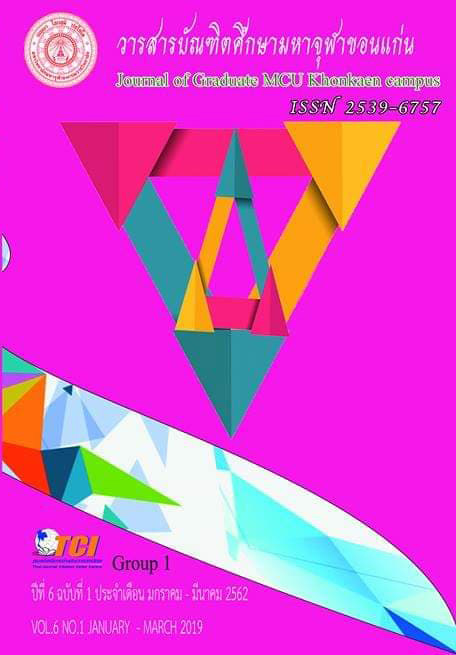Creating the Balance of Life According to the Buddhist Doctrines
Main Article Content
Abstract
The aims of this research were: 1) to study the problematic conditions of life balance of people in the present society of Thailand; 2) to analysis the ways to create the balance of life according to the Buddhist doctrines. Key informants 21 persons consists of academic Buddhist monks, insight meditation instructors, religious academic and Dhamma practitioners at insight meditation center no 1, Wat Pho, Nontan, Khonkaen Province. This qualitative research had its tools as 1) observation; 2) group dynamic meeting; 3) in-depth interview. The obtained data were interpreted by using the descriptive analysis based on the deductive method.
The research results were as follows:
The problem of the life balance in the present Thai society is materialism. People pay attention to material prosperity rather than psychological growth. There is a mental state that has deteriorated; people have no disciplines, no morality and ethics and lack of compassion. They only focus on personal benefits more than common interests and do everything to get what they want to satisfy their desire which is the endless unwholesomeness of human beings.
The guidelines for creating a balance of life according to the principles of Buddhism starts where people have to create their life balance in all aspects in which each aspect should bring the principles of Threefold Learning (ti-sikkhā) together with other related dhammas to practice order to be more effective. If the person is performing this correctly, it will cause balance of life. They will be a stable mental health person which will result in good physical health, having a stable mind and emotion and a good economy as they happily live with sufficiency in society. Everyone in society is equal, not taking advantage from the others.
Article Details
References
More than 7 Million. Online. Retrieved November 21, 2018. from:
http://www.thaihealth.or.th
Juthathip Umawichanee. (2003). Life and Self-Awareness. (6th ed). Bangkok:
Thammasat Univesity Publisher.
Kaewwiboon Sangphonsit. (2018). Treatment the Balance of Life. Online.
Retrieved July 27, 2018. from: https:// www. gotoknow.org/
posts/129695
King Bhumiboladulyadej. (2009). Royal Guidance of His Majesty the King
BhumibolAdulyadej. Bangkok: New Building SuanAmporn.
Office of the National Economics and Social Development Board. (1996).
The Eight National Economic and Social Development Plan (1997-
2001). Bangkok: Office of the National Economics and Social
Development Board.
Mahachulalongkornrajavidyalaya. (1996). Tipitaka of M.C.U.Version.
(1st ed.). Bangkok: Mahachulalongkornrajavidyalaya Printing house.
PhraBrahmagunabhorn (P.A.Payutto). (2018). Muchimapatipata Muchchengna
dhammathetsana. Kanlaylnatam-Achara Klinsuwan. Online.
Retrieved January 4, 2018. from: https://www.facebook.com/
permalink.php?stryfbid
. (2016). The Twelve National Economic and Social Development
Plan (2017-2001). Bangkok: Office of the National Economics and
Social Development Board.
.(2009). Buddhadhamma Improved and Expanded. (11st ed.).
Bangkok: Mahachulalongkornrajavidyalaya Printing house.
. (2013). Dictionary of Buddhism Version of Dhamma Collection.
(The 1
st additional clear/terminate.). (19th ed.). Bangkok:
Dhammasapa Buddhism.
. (2013). Dictionary of Buddhism Version of Code of Dhamma.
(24th ed.). Bangkok: Dhammasapa Buddhism.
PhraMahaThaveeMahapunyo (lalong). (2018). Balance of life In the view of
Buddhism. Online. Retrieved September 1, 2018. from: http://www.
onab.go.th
Public Relations Technical Development Office. (2018). The problem of Thai
society today. Online. Retrieved March 1, 2017. from: http://
hq.prd.go. th/ prtechnicaldm/ewt _news. php?nid=1619
SiripussornWongthongdee. (2009). Creating a Balance of life and Work.
Knowledge Document’s Stabundamrongrajanuphab. Online.
Retrieved August 5, 2009. from: http://hq.prd.go.th/plan/ download/
article/ article _ 20140403144940.pdf
Sowit Bamrungphak. (2018). Criteria for Considering Good and Bad Conducts
in Buddhism. Mahachula Academic Journal, 5(Special), 1-22.

